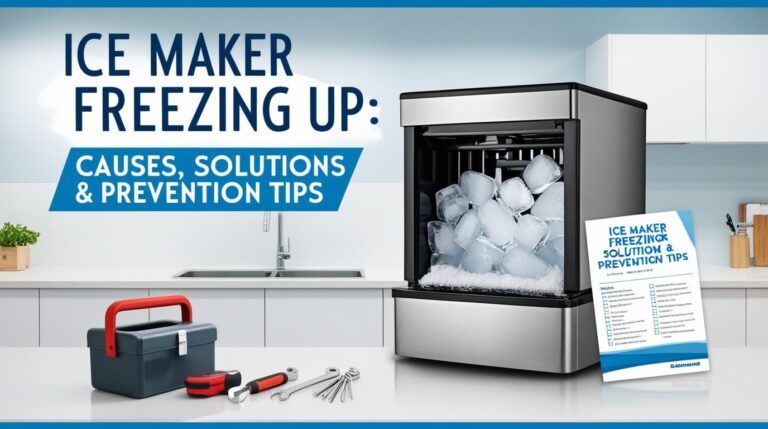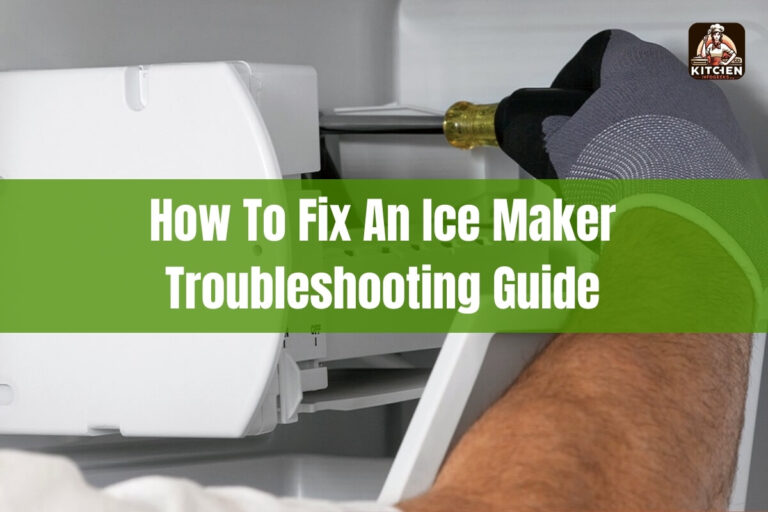
Ice maker not dispensing ice? You’re not alone. This common refrigerator issue can leave you high and dry when you need a cold drink. From simple fixes to complex problems, we’ll explore every angle of this frustrating issue.
In this guide, we’ll tackle the causes, solutions, and preventive measures for ice dispensing problems. You’ll learn how to:
- Identify common culprits behind ice dispensing failures
- Perform step-by-step troubleshooting
- Apply DIY fixes to get your ice flowing again
- Know when it’s time to call in the pros
- Keep your ice maker running smoothly for years to come
Let’s dive in and get your ice maker back on track!
Common Causes of Ice Dispensing Issues
Before we roll up our sleeves, let’s look at why your ice maker might be giving you the cold shoulder.
Ice Clumping and Blockages
Ever opened your freezer to find a glacier instead of ice cubes? Ice clumping is a frequent offender in the world of dispensing troubles. When ice sits too long or melts slightly and refreezes, it can form a solid mass that won’t budge through the dispenser.
Mechanical Problems
Your ice maker is like a mini factory, with moving parts that can wear out or break. Common mechanical issues include:
- Jammed auger motors
- Broken dispenser paddles
- Worn-out gears
These can stop ice in its tracks, even if your maker is producing cubes just fine.
Electrical Issues
Sometimes, the problem isn’t ice at all – it’s electrons. Faulty switches, blown fuses, or control board malfunctions can shut down your dispenser faster than you can say “on the rocks.”
Temperature and Freezer Settings
Ice making is a Goldilocks process – it needs conditions to be just right. If your freezer’s too warm or too cold, you might end up with no ice, or ice that’s too stuck together to dispense.
Step-by-Step Troubleshooting Process
Ready to play detective? Let’s walk through how to pinpoint what’s keeping your ice hostage.
Check the Ice Bin
First things first: is there actually ice in the bin? It sounds obvious, but sometimes the simplest explanation is the right one. If the bin’s empty, your ice maker might not be producing ice at all.
- Remove the ice bin
- Check for ice
- Look for any visible damage or cracks
If the bin’s full but the ice won’t budge, you might have a clumping issue on your hands.
Inspect the Dispenser Mechanism
Now, let’s look at the business end of things – the dispenser itself.
- Examine the dispenser chute for blockages
- Test the dispenser paddle or button
- Listen for the sound of the motor when you try to dispense
If you hear a hum but no ice comes out, you might have a mechanical blockage.
Examine the Water Supply
No water means no ice. Check if your water dispenser is working. If it’s not, you might have a supply issue affecting both systems.
- Ensure the water line isn’t kinked or frozen
- Check if the water inlet valve is open
- Look for any leaks around the refrigerator
A steady water supply is crucial for a happy ice maker.
Verify Freezer Temperature
Grab a thermometer and check your freezer’s temperature. It should be between 0°F and 5°F (-18°C to -15°C) for optimal ice production.
If it’s too warm:
- Ice might melt and refreeze, causing clumps
- The ice maker might shut off to prevent partial freezing
If it’s too cold:
- Ice can become too hard to dispense
- The machine might struggle to eject ice from the molds
Test the Dispenser Controls
Some refrigerators have safety features that can accidentally get triggered.
- Check if the control panel is locked
- Ensure the ice maker is turned on
- Try both crushed and cubed ice settings, if available
Sometimes, a simple button press can solve your ice woes.
DIY Solutions for Ice Dispensing Problems
Now that we’ve identified potential culprits, let’s talk fixes. Many ice maker issues are solvable with a bit of elbow grease and know-how.
Clearing Ice Jams
Battling the ice berg in your freezer? Here’s how to break it up:
- Remove the ice bin
- Empty it completely
- Use a wooden spoon to break up any clumps gently
- Avoid metal tools – they can damage the bin
For stubborn clumps, let the bin sit at room temperature for a few minutes, but don’t let it melt completely.
Cleaning the Ice Maker and Dispenser
A clean ice maker is a happy ice maker. Regular cleaning can prevent many dispensing issues.
- Unplug the refrigerator
- Remove and wash the ice bin with mild soap and warm water
- Clean the dispenser chute with a soft brush
- Wipe down the auger and other visible parts
- Dry everything thoroughly before reassembling
Pro tip: A solution of equal parts water and white vinegar can help dissolve mineral buildup.
Adjusting Freezer Settings
If temperature’s the issue, a quick adjustment might do the trick:
- Locate your freezer’s temperature controls
- Adjust in small increments
- Wait 24 hours between adjustments to let the temperature stabilize
Remember, the sweet spot is 0°F to 5°F (-18°C to -15°C).
Resetting the Ice Maker
Sometimes, your ice maker just needs a fresh start:
- Locate the reset button (check your manual for its position)
- Press and hold for a few seconds
- Listen for a chime or watch for a light indicating a reset
- Wait 24 hours for a complete cycle
No reset button? Try unplugging your refrigerator for a minute, then plugging it back in.
When to Call a Professional
DIY is great, but sometimes you need to know when to throw in the towel (or ice scoop, in this case).
Signs of Serious Malfunctions
Call a pro if you notice:
- Unusual noises from the ice maker
- Water leaks inside the freezer
- Ice maker won’t turn off
- Repeated failures after DIY fixes
These could indicate more complex issues requiring expert attention.
Warranty Considerations
Before you start taking things apart, check your warranty status. Many refrigerators have separate warranties for the ice maker. Attempting repairs yourself might void your coverage.
Cost of Professional Repairs
Professional ice maker repairs typically range from $200 to $400. While not cheap, it’s often less than replacing the entire unit. Plus, you get the peace of mind of a job done right.
Maintaining Your Ice Maker for Optimal Performance
An ounce of prevention is worth a pound of cure – or in this case, a bucket of ice.
Regular Cleaning Schedule
Mark your calendar:
- Clean the ice bin monthly
- Sanitize the entire system every 3-6 months
- Replace the water filter as recommended (usually every 6 months)
Regular cleaning prevents buildup that can cause dispensing issues.
Proper Usage Tips
Treat your ice maker right:
- Don’t overfill the ice bin
- Use the ice scoop, not your hands (to prevent contamination)
- Keep the freezer door closed as much as possible
These simple habits can extend your ice maker’s life and performance.
Preventive Maintenance Techniques
Stay ahead of problems:
- Check for leaks regularly
- Listen for unusual noises
- Keep the coils clean (vacuum them every few months)
- Inspect door seals for tight closure
Catching issues early can save you from major headaches (and repair bills) down the line.
Frequently Asked Questions About Ice Maker Dispensing Issues
Let’s tackle some common head-scratchers about ice maker troubles.
Why does my ice maker make ice but not dispense it?
This often points to a mechanical issue. The ice maker might be working fine, but the dispensing mechanism could be jammed or broken. Check for ice clumps blocking the chute or a faulty dispenser motor.
How often should I clean my ice maker?
Clean your ice bin monthly and do a deep clean of the entire system every 3-6 months. This routine keeps things hygienic and helps prevent dispensing issues.
Can a clogged water filter affect ice dispensing?
Yes! A clogged filter can reduce water flow, leading to smaller ice cubes or slower production. This can indirectly cause dispensing problems. Replace your filter every 6 months or as recommended by the manufacturer.
Why is my ice dispenser slow or producing small cubes?
Several factors can cause this:
- Low water pressure
- Partially closed water inlet valve
- Clogged water filter
- Freezer temperature set too high
Check these elements if you’re getting a trickle instead of a avalanche of ice.
wrapping up
Ice maker not dispensing ice? It’s a common hiccup, but now you’re armed with the knowledge to tackle it head-on. Remember, regular maintenance is key to avoiding most dispensing issues. Clean regularly, listen for unusual noises, and don’t ignore small problems – they can become big ones if left unchecked.
By following the troubleshooting steps and maintenance tips we’ve covered, you’ll keep your ice maker running smoothly. And when in doubt, don’t hesitate to call in the pros. After all, a working ice maker is more than a luxury – it’s an essential part of a well-functioning kitchen.
Stay cool, and may your glasses always be full of perfectly dispensed ice!






